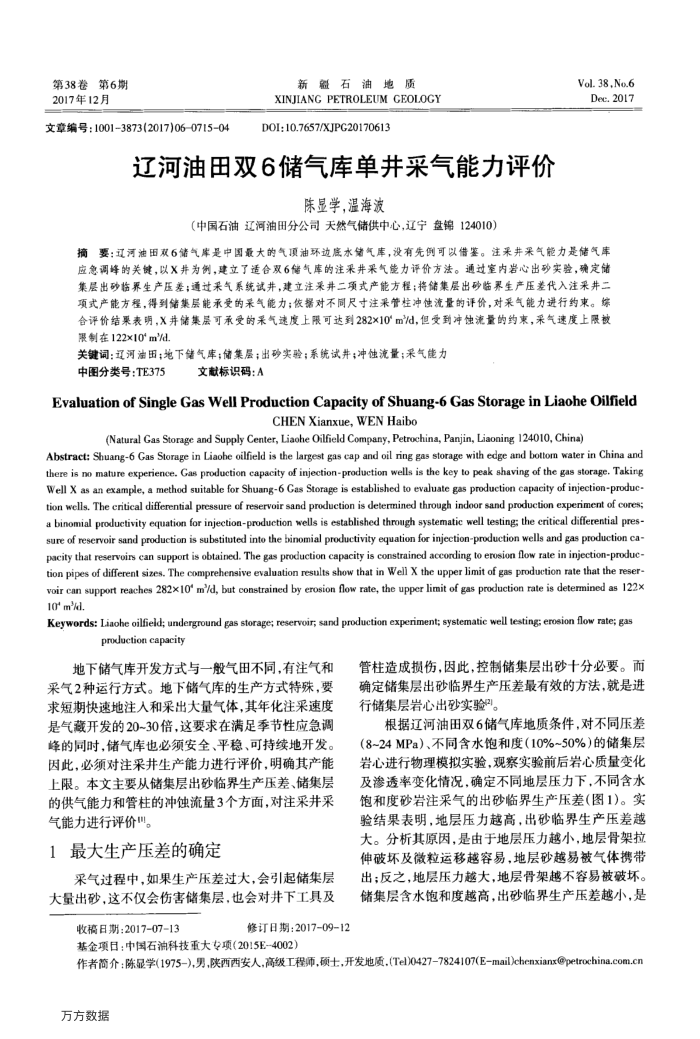您当前的位置:首页>论文资料>辽河油田双6储气库单井采气能力评价
内容简介
 第38卷第6期 2017年12月
第38卷第6期 2017年12月文章编号:1001-3873(2017)060715-04
新盘石油地质
XINJIANG PETROLEUM GEOLOGY DOI:10.7657/XJPG20170613
辽河油田双6储气库单井采气能力评价
陈显学,温海波
(中国石油辽河油田分公司天然气储供中心,辽宁盘锦124010)
Vol.38,No.6 Dec.2017
摘要:辽河油田双6储气库是中国最大的气顶油环边底水储气库,没有先例可以借鉴。注采井采气能力是储气库应急调峰的关键,以X并为例,建立了适合双6储气库的注采井采气能力评价方法。通过室内岩心出砂实验,确定储集层出砂临界生产压差;通过采气系统试井,建立注采并二项式产能方程;将储集层出砂临界生产压差代入注采井二项式产能方程,得到储集层能承受的采气能力;依据对不同尺寸注采管柱冲蚀流量的评价,对采气能力进行约束。综合评价结果表明,X井储集层可承受的采气速度上限可达到282x10°md,但受到冲蚀流量的约束,采气速度上限被
关键词:辽河油田;地下储气库;储集层;出砂实验;系统试井;冲蚀流量;采气能力
中图分类号:TE375
文献标识码:A
Evaluation of Single Gas Well Production Capacity of Shuang-6 Gas Storage in Liaohe Oilfield
CHEN Xianxue, WEN Haibo
(Natural Gas Storage and Supply Center, Liaohe Oilfield Company, Petrochina, Panjin, Liaoning 124010, China)
Abstract: Shuang-6 Gas Storage in Liaobe oilfield is the largest gas cap and oil ring gas storage with edge and botom water in China and there is no mature experience, Gas production capacity of injection-production wells is the key to peak shaving of the gas storage. Taking Well X as an example, a method suitable for Shuang-6 Gas Storage is established to evaluate gas production capacity of injection-produc-tion wells, The critical differential pressure of reservoir sand production is determined through indoor sand production experiment of cores; a binomial productivity equation for injection-production wells is established through systematic well testing; the critical differential pres-sure of reservoir sand production is substituted into the binomial productivity equation for injection-production wells and gas production ca-pacity that reservoirs can support is obtained. The gas procuction capacity is constraincd according to erosion flow rate in injection-produc tion pipes of different sizes. The comprehensive evaluation results show that in Well X the upper limit of gas production rate that the reser-voir can support reaches 282×10° m/d, but constrained by erosion flow rate, the upper limit of gas production rate is determined as 122x 10°m%
Keywords: Liaohe oilfieid; underground gas storage; reservoir; sand production experiment; systematic well testing; erosion flow rate; gas
production capacity
地下储气库开发方式与一般气田不同,有注气和采气2种运行方式。地下储气库的生产方式特殊,要求短期快速地注人和采出大量气体,其年化注采速度是气藏开发的20~30倍,这要求在满足季节性应急调峰的同时,储气库也必须安全、平稳、可持续地开发。因此,必须对注采井生产能力进行评价,明确其产能上限。本文主要从储集层出砂临界生产压差、储集层的供气能力和管柱的冲蚀流量3个方面,对注采井采气能力进行评价!。
最大生产压差的确定 1
采气过程中,如果生产压差过大,会引起储集层大量出砂,这不仅会伤害储集层,也会对井下工具及
收稿日期:2017-07-13
修订日期:2017-09-12
管柱造成损伤,因此,控制储集层出砂十分必要。而确定储集层出砂临界生产压差最有效的方法,就是进行储集层岩心出砂实验。
根据辽河油田双6储气库地质条件,对不同压差(8~24MPa)、不同含水饱和度(10%~50%)的储集层岩心进行物理模拟实验,观察实验前后岩心质量变化及渗透率变化情况,确定不同地层压力下,不同含水饱和度砂岩注采气的出砂临界生产压差(图1)。实验结果表明,地层压力越高,出砂临界生产压差越大。分析其原因,是由于地层压力越小,地层骨架拉伸破坏及微粒运移越容易,地层砂越易被气体携带出;反之,地层压力越大,地层骨架越不容易被破坏。储集层含水饱和度越高,出砂临界生产压差越小,是
基金项日:中国石油科技重大专项(2015E-4002)
作者简介:陈显学(1975-),男,陕西西安人,高级工程师,硕士,开发地质,(Tel)0427-7824107(Email)chenxianxpetrochina.com.cn 万方数据